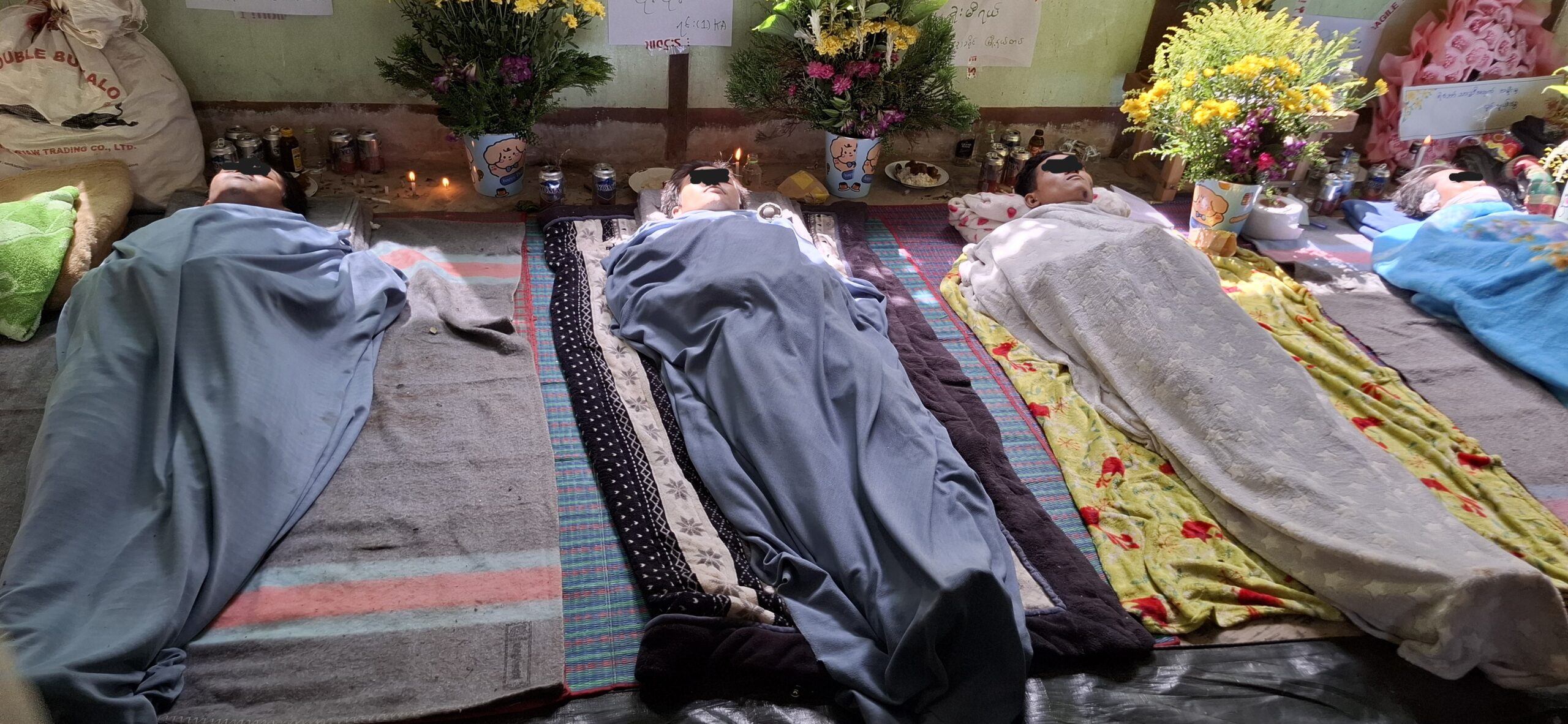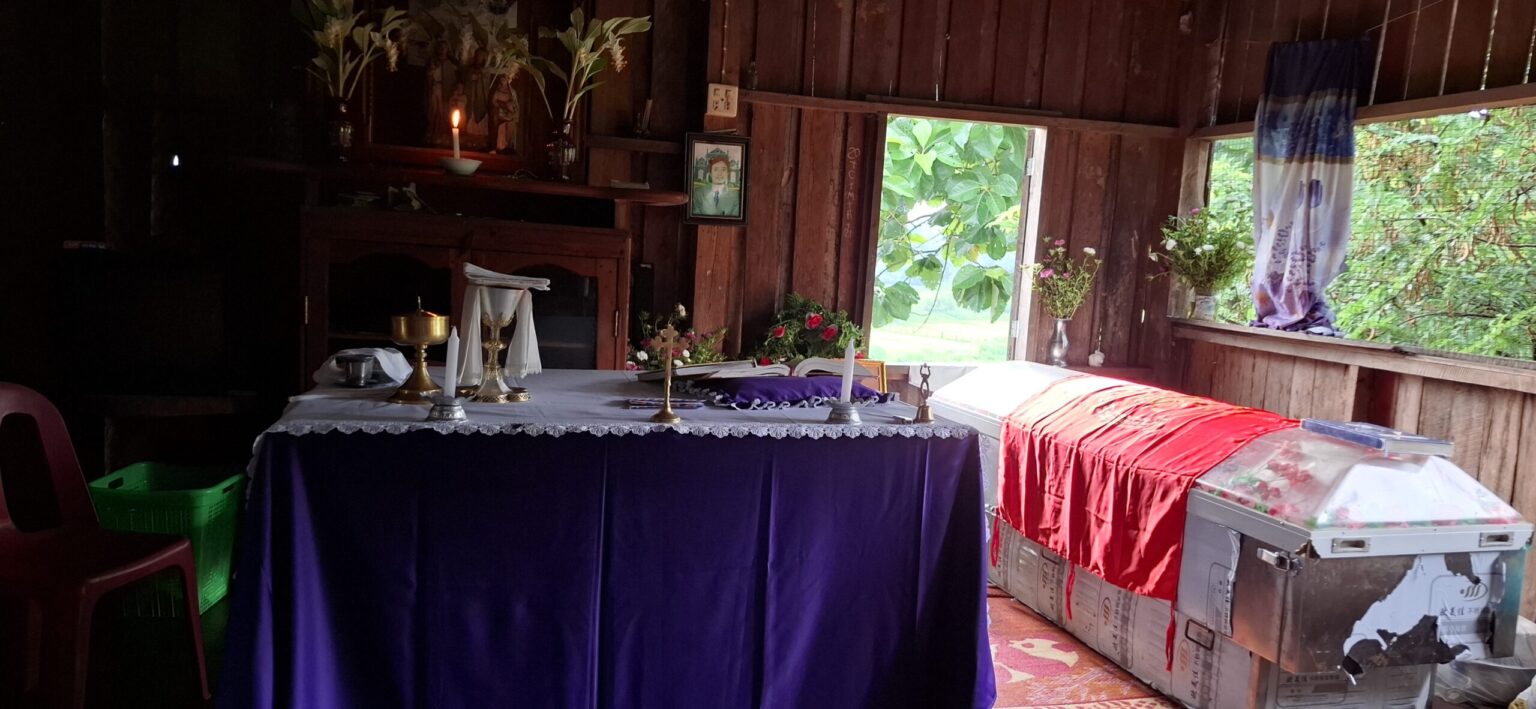The Karenni resistance forces currently hold most of the territory of Karenni State, as well as parts of the Karenni-majority areas in neighboring Shan State. However, their final push to drive the junta out of the urban centers has been slow.
The Battle of Pasaung, which began on August 14, was a crucial step in securing Karenni control of their territory. Yet the junta’s overwhelming advantage in airpower, artillery, drones, and mortars inflicted serious casualties on the resistance.
My other stories about the lead-up to the battle and the early part of the fight itself are on The Gateway Pundit.
The morning after the battle of Battle of Pasaung, on August 15, I accompanied the priest to the funerals for the Karenni soldiers who were killed. When a soldier is killed at the front, the body is washed and sent back to his unit, where a mass wake is held for all the soldiers lost from that unit. Later, the bodies are moved to the family home for the funeral mass, if the soldier is Catholic. This unit had lost seven men, but across all units the death toll from that single day of fighting was much higher.

The bodies were laid out, wrapped in blankets with offerings near their heads and a picture of each soldier in life. Above each body was a handwritten sign with the soldier’s name and unit. The embalmers worked hurriedly in full view of mourners and families, pumping the bodies full of chemicals to reduce the smell so the families could hold a funeral the next day.
The grief at a unit wake is especially heavy because the soldiers often come from the same communities and are sometimes related. Each death strikes deeper across the civilian population. Soldiers, siblings, civilians, all are affected, but the toll on the mothers is indescribable. Even worse, some soldiers had escaped government-controlled areas to join the resistance.
Because their parents still lived under the regime, the bodies could not be returned home or the families would be punished. Those mothers had to learn of their sons’ deaths over Starlink, if they even had access, and would never have the closure of a funeral.
Father told me that one of the Catholic soldiers who was killed had already been wounded during the last attempt to take Pasaung, back in February and March. He recovered, returned to the fight, and this time he was killed. The soldier’s name was Gianni. He was only 20 years old. And now he would never be 21.
The next morning, the deacon who assisted Father during the funeral mass was a seminarian about to be ordained as a priest. He was also Gianni’s cousin, again driving home just how small and tightly knit these communities are. At Gianni’s head was a heroic picture of him in life, having made the decision to risk death in order to protect his people.
There was also an offering table with incense, candles, beer, and Gianni’s favorite snacks. I asked Father about this, since it’s generally what we see at funerals for Buddhist soldiers, but he explained that it is a local tradition, and normal even for Catholics. At Gianni’s feet was a stack of his rucksack and military equipment, which, in a similar fashion, would be buried with him.
Father asked me to say a few words at the funeral. And so, I reminded the faithful of Job. I told them that I don’t know why the people of Burma are suffering, and I don’t know when the war will end, only God knows that.
But like Job, their faith is being tested, and like Job, they remain true to their belief in God. I then reminded them that Gianni’s sacrifice was the fulfillment of John 15:13: “Greater love hath no man than this, that a man lay down his life for his friends.”
Hollywood tells us that soldiers suffer trauma because of the people they have killed. But killing the enemy causes far less trauma than experiencing the loss of innocents. In battle, the small handful of medics witness every single injury and death. Back in the village, the priest must bury all the dead, many of whom he baptized as children.
And the families are bombarded from all sides with news of cousins, relatives, and sons—both soldiers and civilians, killed and displaced on a daily basis. The trauma runs through the entire society. And while it is a shared experience, each person endures their own separate war.
The resistance suffers from a shortage of vests, and helmets are almost nonexistent. Even worse, they face a shortage of weapons and bullets. I personally saw soldiers going to the front without weapons, and one soldier told me he only had three bullets—.22 caliber. In the battle, nearly all of the casualties came from airstrikes, mortars, drones, and artillery, which suggests that most of the resistance soldiers never got close enough to fire at the junta troops.
The impact China and Russia are having on this war is obvious, and the asymmetrical nature of the fighting is largely the result of international law. Despite sanctions, the junta can import unlimited quantities of advanced weapons from China and Russia.
At the same time, it is illegal for the resistance to smuggle even small amounts of bullets into the country. Getting caught smuggling Starlink equipment or a drone jammer can result in years in prison.
The West and the UN have condemned the junta and rejected the coup, yet international law favors the regime. The resistance has been fighting for 80 years with whatever weapons they can scrounge or make. It is obvious they will not quit. So, the deaths will continue forever, unless the international community effectively cuts off the junta’s supply of jet fuel, weapons, and ammunition from China and Russia.
Read the full article here


